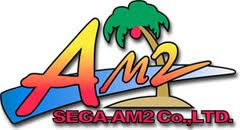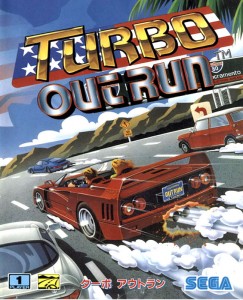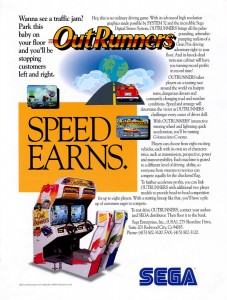We’re seeing a resurgence of the OutRun franchise with the release of OutRun 2 on Xbox. Though this newest incarnation implies that it is the second game to carry the name, there have actually been several releases over a multitude of consoles and in the arcade. With a history spanning almost twenty years, it’s very hard to have been a gamer for long and not have played even one entry in the series.
Developer History
 OutRun was the brainchild of gaming guru Yu Suzuki; the man responsible for such famous games as Hang-On, After Burner, Virtua Fighter, Space Harrier, and most recently Shenmue. During his second year at Sega, Suzuki created a series of games whose main CPU was centered around twin 68000 processors. Four titles used this new board: Super Hang-On, Super Hang-On LE, OutRun, & Turbo OutRun. Super Hang-On was a hit but it was OutRun that really exploded and made Suzuki a force to be reckoned with within the industry. Racing games had always been a successful staple of the market and even Sega had experienced good sales with games like Monaco GP and Turbo. However, Suzuki wanted to go beyond the tired old formula most racing games used at the time and instead continue to expand the engine he had created with Hang-On. He had long been a fan of Ferraris and now wanted to incorporate that love into a title that would be both fun and exhilarating to play. He came up with a concept where players hopped into a Ferrari Testarossa and raced against the clock through several different stages, which they chose via branching paths at the end of the current stage. A racing game of this type had never been done before and it was quickly embraced by gamers everywhere.
OutRun was the brainchild of gaming guru Yu Suzuki; the man responsible for such famous games as Hang-On, After Burner, Virtua Fighter, Space Harrier, and most recently Shenmue. During his second year at Sega, Suzuki created a series of games whose main CPU was centered around twin 68000 processors. Four titles used this new board: Super Hang-On, Super Hang-On LE, OutRun, & Turbo OutRun. Super Hang-On was a hit but it was OutRun that really exploded and made Suzuki a force to be reckoned with within the industry. Racing games had always been a successful staple of the market and even Sega had experienced good sales with games like Monaco GP and Turbo. However, Suzuki wanted to go beyond the tired old formula most racing games used at the time and instead continue to expand the engine he had created with Hang-On. He had long been a fan of Ferraris and now wanted to incorporate that love into a title that would be both fun and exhilarating to play. He came up with a concept where players hopped into a Ferrari Testarossa and raced against the clock through several different stages, which they chose via branching paths at the end of the current stage. A racing game of this type had never been done before and it was quickly embraced by gamers everywhere.
The Games
Upon its release in September of 1986, the original OutRun took arcades by storm with its awesome graphics and gameplay. As soon as you saw the screen you knew it was different. Along with both Hang-On titles, OutRun was one of the first titles to incorporate a “chase car” view (though both Pole Position and Sega’s own Turbo predated them), as opposed to the standard aerial view used by games of the time and this made it stand out in arcades from the get-go. It was also the second game to feature Sega’s “super scaler technology” (Space Harrier was the first). Gamers loved driving a Ferrari and were enthralled at the ability to choose their background music as well as the next course at the end of each stage; often coming back to play several times just to see all the different tracks. It was both refreshing and unique, with two different versions released in arcades (upright and deluxe). The graphics changed with each stage, even going so far as to include effects like sand that could slow you down. There were a total of five different endings and this would become the standard for the series.
Ported to just about every system, including the Master System, Genesis, PC-Engine, Game Gear, and Commodore 64; OutRun finally received the port it deserved when it came out for the Sega Ages series of games for the Saturn (although the Genesis version was very good). This was packaged stateside by Working Designs and included Space Harrier and After Burner II.
Sega quickly capitalized on OutRun‘s success by releasing a sequel in Turbo OutRun. Featuring all the same fast paced gameplay of the original, it added the mechanic of a turbo button that was now critical for making the checkpoint in time. The turbo could be used as long as the motor was cool. Overuse caused it to overheat and left you without the valuable boost for a few seconds. Some changes were also made to the style of play by no longer allowing you to choose your path at the end of a stage. There were now four areas to pass, with sixteen different stages in all. Successful completion of a stage gave you additional engine, turbo, and tire options to buy. You also now had a rival to compete against and if he beat you after four stages, your lady friend would leave you for him! Though successful, many gamers were dismayed at the game’s new linearity, preferring instead the different courses from the first game.
Turbo OutRun was also designed to be easy on arcade owners who didn’t want another new cabinet. To compliment the deluxe cab, a simple conversion kit was made available that could be easily and quickly installed in existing OutRun games. OutRun.org summed it up best:
“Turbo Outrun was just PCB add on, or maybe replacement for the exact same cabinet. Some vendors would just buy the add on card, and stick it into the expansion slot of the original Outrun PCB, and it would change the game to Turbo Outrun. It also came with additional decals and marquee to use on the original cabinet.”
The game was ported to the Mega Drive (it never came to the U.S.) and while faithful to the arcade version, it simply lacked the charm and overall polish of the original OutRun (It had a larger memory size but still suffered from choppy scaling).
In addition to both OutRun and Turbo OutRun, the Genesis was also given an original game called OutRun 2019. Set in a future where cars could reach speeds in excess of 600Mph, it brought back the branching paths from the first game, only now there were elevated roads to take. This added some challenge in that you could fall off if you weren’t careful on those tight turns. The scaling was decent and the music, though not in the typical OutRun style, was quite good.
 Not only tearing up the arcade and Genesis scenes, the franchise also made a splash on the Master System. In addition to a very competent port of the original, a total of three other titles were released for Sega’s 8-bit underdog, mostly distinguishing themselves for the lukewarm twists they brought to the gameplay. OutRun 3D required the Master System 3D glasses to play (you remember them, right? Twenty pounds heavy and seizure-inducing?). It was possible to play in 2D mode but that would kind of defeat the purpose, wouldn’t it? The effect was actually pretty good and the game was a decent version, given the hardware. Master System fans trying to find a copy may be in for some difficulty, as the 3D titles tend to go for quite a bit on eBay.
Not only tearing up the arcade and Genesis scenes, the franchise also made a splash on the Master System. In addition to a very competent port of the original, a total of three other titles were released for Sega’s 8-bit underdog, mostly distinguishing themselves for the lukewarm twists they brought to the gameplay. OutRun 3D required the Master System 3D glasses to play (you remember them, right? Twenty pounds heavy and seizure-inducing?). It was possible to play in 2D mode but that would kind of defeat the purpose, wouldn’t it? The effect was actually pretty good and the game was a decent version, given the hardware. Master System fans trying to find a copy may be in for some difficulty, as the 3D titles tend to go for quite a bit on eBay.
Another variation was Battle OutRun, which was essentially a Chase HQ rip off without any of the elements that made that title good. The gameplay was watered down and the graphics were sub par to say the least. Random obstacles, like oils slicks and even ramps (?) were added to try and liven up the ho-hum track design but even this could not overcome Battle’s sheer dullness. It is considered rare on the Master System today, although this would have to do more with the amount of copies pressed than it would with the game’s quality.
OutRun Europa was an attempt to add a plot to go along with the gameplay. While the thought of having a story in an OutRun game may seem like something worthwhile, why bother now? The series had never been about anything but racing to the finish line and that was always enough. Unfortunately, having you use a motorcycle and jet ski wasn’t as innovative as you’d like to think, since the frustrating control ruined any fun to be had. Europa was released for the Game Gear, Amiga, Commodore 64, and Zx Spectrum.
While all these versions had their advantages and disadvantages, the one sequel that honestly stands out in my mind as the next true step in the series’ evolution has to be the arcade release of OutRunners. Appearing on Sega’s powerful System32 hardware, there were eight different cars to drive; each with different types of transmission, maneuverability, and engine power. This amazing game was available in both a horizontal cab as well as a twin deluxe cabinet and featured head-on play for two people. Even more incredible was that up to four cabs could be connected, allowing for eight players to compete simultaneously!
Stages were divided into east and west, with fourteen stages for each direction. That gave a total of twenty-eight stages to race through! Combined with the ability to compete against a human opponent, this made the game an OutRun fan’s wet dream. Just about all the tunes from the original game are present and there are at least that many new songs to boot.

A mediocre port was released for the Genesis by Data East and though it had all the elements of the arcade version, you had to play in split-screen mode all the time (even in single player games). The sound was shoddy and the graphics were not on par with even the original OutRun port.
The series has yet again reached a new level of greatness with the release of OutRun 2 for the arcade and Xbox. Brought finally into the 3D realm, this newest edition has combined the best features of the original (branching paths, Ferraris, classic music) and has added all the next gen bells and whistles gamers are used to in a modern racer. Aside from the standard arcade race (OutRun mode), you can now challenge a Time Attack mode, versus mode (4 players in the arcade, eight on Xbox Live or system link), and Heart Attack mode (impress your girlfriend with your driving!). The Xbox version also sports a career mode, where you must complete over a hundred missions with different goals. Moreover, Live play lets you download other people’s ghosts (a la Project Gotham Racing 2) to race against or upload your own. The game has a fairly large selection of cars to use as well as lots of secrets, like stages from Super GT and Daytona 2 to unlock!
OutRun for the Future?
It looks like OutRun 2 will be a great seller on the Xbox when it’s released this month. Hopefully, this will mean that we’ll see more OutRuns in the future and maybe even a compilation someday (we need an arcade-perfect port of OutRunners!). Considering that until a few months ago Sega wasn’t even planning to port the game to Xbox, there may yet be hope for the series to continue for years to come.
The complete release chronology is as follows:
- OutRun, Arcade (1986)
- OutRun, Commodore 64 (1987)
- OutRun, Sega Master System (1987)
- OutRun, Amiga Computer (1988)
- OutRun, Sinclair Zx Spectrum (1987)
- OutRun, Amstrad CPC (1987)
- OutRun, MSX2 (1988)
- OutRun, Commodore Amiga (1988)
- OutRun, Atari ST Computer (1989)
- OutRun, PC [MS-DOS 5.5”] (1989)
- OutRun 3D, Sega Master System (1989)
- Battle OutRun, Sega Master System (1989)
- OutRun, LCD Table-Top Game (1989)
- Turbo OutRun, Sinclair Zx Spectrum (1989)
- Turbo OutRun, Atari ST (1989)
- Turbo OutRun, Commodore 64 (1989)
- Turbo OutRun, Commodore Amiga (1989)
- Turbo OutRun, Arcade (1990)
- OutRun, PC-Engine (1990)
- Turbo OutRun, PC [MS-DOS] (1990)
- OutRun, Genesis, (1991)
- OutRun, Game Gear (1991)
- OutRun Europa, Atari ST [UK] (1991)
- OutRun Europa, Game Gear [UK] (1991)
- OutRun Europa, Sega Master System [UK] (1991)
- OutRun Europa, Sinclair Zx Spectrum [UK] (1991)
- OutRun Europa, Amiga [UK] (1991)
- OutRun Europa, Commodore 64 [UK] (1991)
- Turbo OutRun, Genesis (1992)
- OutRunners, Arcade (1992)
- OutRun 2019, Genesis (1993)
- OutRunners, Genesis (1994)
- OutRun, Saturn (1996)
- OutRun, PC-CD ROM [Sega Smash Pack] (1999)
- OutRun, Sega Dreamcast [Yu Suzuki Game Works Vol. 1] (2001)
- OutRun, Sega Dreamcast [Shenmue II] (2001)
- OutRun, Xbox [Shenmue II] (2002)
- OutRun, Mobile Phones (2002)
- OutRun, Game Boy Advance [Sega Arcade Gallery] (2003)
- OutRun 2, Arcade (2004)
- OutRun 2, Xbox (2004)
- OutRun, Arcade [OutRun 2 unlockable] (2004)
- OutRun 2 SP, Arcade (2004)
- OutRun, PlayStation 2 [Sega Ages Vol. 13] (2006)
- OutRun 2006: Coast 2 Coast, Xbox/PlayStation 2/Sony PSP/PC (2006)
- OutRun Online Arcade, Xbox Live Arcade [NA]/PlayStation Network [EU] (2009)
Updated April, 2009
Sources
- Game Info. Arcade History Database, 2004.
- Game Info. OutRun.org, 2004.
- Game Info. Xbox.com OutRun 2 Feature, 2004.
- “OutRun 2 Hands-On Preview.” Team Xbox.com. Aug. 30, 2004.

Recent Comments